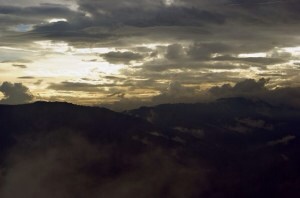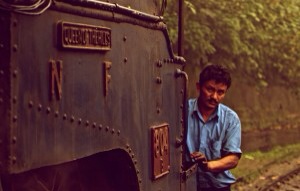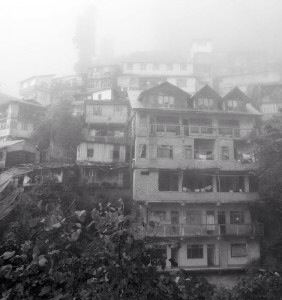As I was driven up the winding road into the Himalayas in the back of our hired 4X4 I remember thinking how different this was from the hustle and bustle of Bangalore. Having spent the last two months working in India’s IT capital I was soothed by the quiet that now surrounded us. No more trumpeting car horns, no more shouts of anger from the auto-rickshaw drivers as they attempted to navigate the hectic streets swarming with cars, pedestrians and, of course, the obligatory cows meandering down the middle lane. No, this was peaceful. And as we meandered higher and higher into the foothills of Everest the rolling hills spread out across the horizon. Soon, the view was one undulating patchwork of rises and falls, with soft clouds nestling in the dips and valleys below us.
Looking ahead, the seemingly endless road crept higher into the beautiful countryside, cutting sweeping pathways through the tea estates that dotted the landscape. These vast terraces of tea trees are the source of the world famous Darjeeling tea, one of the major sources of income in the region, alongside tourism. From these humble plants, 10,000 tonnes of high-quality tea is produced each year and sold around the world. The higher we climbed into the mountains, the easier it was to spot the differences in culture with the rest of the Indian sub-continent. The Hindu shrines gave way to Buddhist prayer flags and Tibetan prayer wheels, and the locals took on a more Nepalese appearance. This was an unfamiliar India to what I had experienced on the rest of my travels, and this difference was visible in the murals and political posters dotted along our route seeking independence for Gorkhaland, an ethnic area in which Darjeeling is situated. Ramshackle huts lined the narrow road now flanked by the tracks of the famous Darjeeling Himalayan Railway. This toy train is a narrow gauge railway that runs from New Jalpaiguri to Darjeeling via Kurseong, and is often listed as one of the must-sees before you die. The steam powered locomotive was one of the reasons I came to the region, and as its tracks snaked across the road and joined the cars in the newly formed traffic jam I sat anticipating my journey in its carriages.
The next day I was on the platform in the monsoon rain queuing up for my ticket on the tourist leg of the toy train from Darjeeling to Ghum, the highest train station in India. Standing with the steam blowing across my face I realised how integrated the railway had become into Darjeeling life. Workers, families, goods and produce all found their way through the Himalayas on this little toy train, it was the lifeline that kept the blood pumping into the mountain towns and villages. The railway also injected much-needed finance into the area through the tourists like me who pay to ride the tracks from Darjeeling to Ghum. Along the route is a stop-off at the Darjeeling War Memorial at Batasia Loop. Commemorating the loss of Gorkha soldiers lives in conflict post Indian independence, the memorial comprises a granite cenotaph and a bronze statue of a lone Gorkha soldier, as well as a roll of honour for all the fallen soldiers. It is another reminder of the pride of the Gorkha people, and the reverence with which they hold those who fight for the cause. Arrival at Ghum presented me with the opportunity of a wet walk back to Darjeeling in the rain, and a chance to view the famous Bhutia Busty Monastery. Having previously been destroyed by invasions and earthquakes the monastery is now home to both Hindus and Buddhists, and is widely recognised as the oldest monastery in Darjeeling (even if it has been rebuilt and relocated on numerous occasions). It is a beautiful building, and the grounds offer a quiet place to sit back and relax in the search for enlightenment. Having supped on traditional Tibetan food (I do not recommend the butter tea made from rancid yak’s milk) I slept soundly amongst the clouds in my hotel room before rising for my second day in the Himalayas. This started with a trip to the Darjeeling zoo, the only park in India recognised for its conservation breeding programmes, which houses amazing creatures such as red pandas, Himalayan black bears, snow leopards and, of course, tigers. The zoo is also home to the world-renowned Himalayan Mountaineering Institute While the zoo is well worth a visit, the highlight of the day for me was a walk through the town to reach the botanical gardens. The walk revealed the local meat markets, with huge cuts of meat hanging from butchers hooks, cobblers fixing shoes, and tobacconists selling paan, the local chewing tobacco. Interacting with the locals allowed me to get a greater feel for the hilltop community, whether that be playing football with a bunch of school children in the pouring rain or being lead across a gorge on a rusty girder by an elderly man with an umbrella.
One individual even invited me to view the school where he was headmaster next time I was in India while we chatted over a hot cup of chai. The gardens themselves were a thing of beauty, even in the rain, with native plants of the area, as well as rare orchids and cacti. The following day it was my time to leave this mountain retreat. And as I drove back down the hills towards Bogdagra Airport and the final leg of my journey back to England, I appreciated why this area was so sought after by the British before Indian independence. Darjeeling is one of the most remarkable places I have been. It is just so peaceful and beautiful and, whilst I stayed there, even for such a brief amount of time, I really was living in the clouds.




Great post, beautifully captured
LikeLike
Thanks Tina. It still lives on as a fond memory. I have to go back one day…
LikeLike